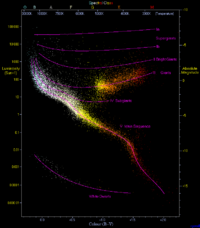
Photo from wikipedia
Main sequence turn-off (MSTO) stars have advantages as indicators of Galactic evolution since their ages can be robustly estimated from atmospheric parameters. Hundreds of thousands of MSTO stars have been… Click to show full abstract
Main sequence turn-off (MSTO) stars have advantages as indicators of Galactic evolution since their ages can be robustly estimated from atmospheric parameters. Hundreds of thousands of MSTO stars have been selected from the LAMOST Galactic survey to study the evolution of the Galaxy, and it is vital to derive accurate stellar parameters. In this work, we select 150 MSTO star candidates from the MSTO star sample of Xiang that have asteroseismic parameters and determine accurate stellar parameters for these stars by combining asteroseismic parameters deduced from Kepler photometry and atmospheric parameters deduced from LAMOST spectra. With this sample, we examine the age determination as well as the contamination rate of the MSTO star sample. A comparison of age between this work and Xiang shows a mean difference of 0.53 Gyr (7%) and a dispersion of 2.71 Gyr (28%). The results show that 79 of the candidates are MSTO stars, while the others are contaminations from either main sequence or sub-giant stars. The contamination rate for the oldest stars is much higher than that for younger stars. The main cause for the high contamination rate is found to be the relatively large systematic bias in the LAMOST surface gravity estimates.
Journal Title: Research in Astronomy and Astrophysics
Year Published: 2017
Link to full text (if available)
Share on Social Media: Sign Up to like & get
recommendations!